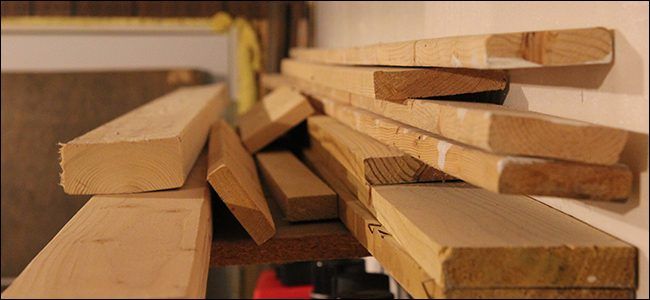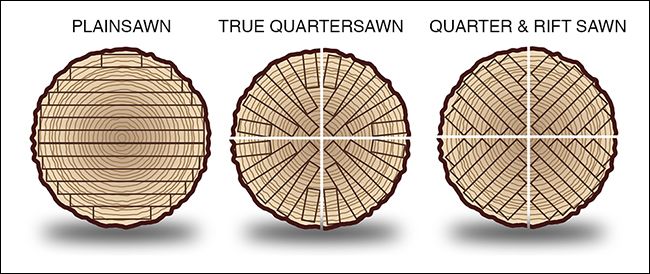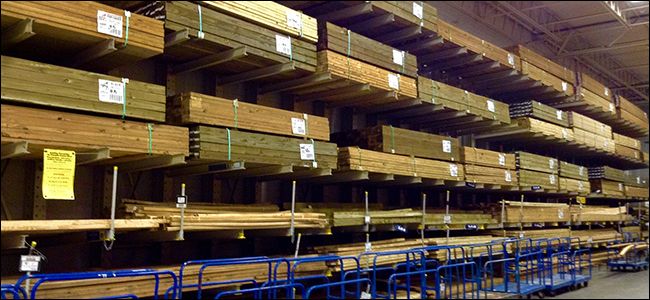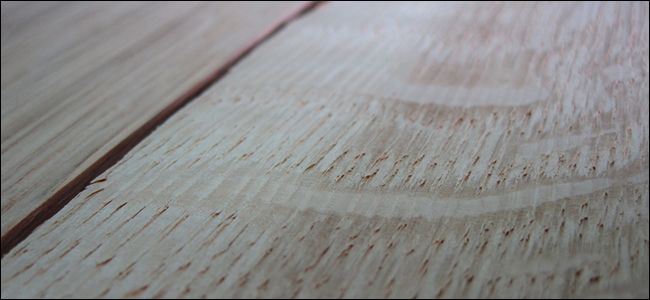If you've ever gone to the hardware store to buy lumber to build that DIY desk or home theater center, you've probably come across your fair share of warped and twisted boards before you finally landed on a decent-looking 2x4. Here's why that is.
How Lumber Is Made
To really understand why lumber sometimes twists, bows, and warps, it's important to first learn how lumber gets made.
Lumber comes from logs that are run through a set of industrial-sized saws and cut down into more manageable pieces. The above graphic is a great example of the different shapes and sizes that can be accomplished using a single log and different types of cutting methods.
Trees are naturally full of moisture on the inside, so when logs get cut up into smaller pieces, those pieces need to dry out. Depending on where the lumber is being made, it will either be air dried or kiln dried.
Air-dried lumber typically begins outdoors and is laid out with spacers between pieces to allow airflow all around. Once the moisture content goes down, it's sometimes brought indoors to dry further and acclimate the lumber to indoor conditions. However, sometimes it's left outdoors to stay acclimated to outdoor conditions, making it better suited for decking, fencing, and patio furniture.
Kiln-dried lumber is dried using a kiln (obviously), but is more expensive to do. However, it's a lot faster than air drying and it takes out more moisture, so kiln-dried lumber is usually less susceptible to twisting and warping.
Once the lumber is dried, it's then fed into planers, which are unique types of saws that shape the wood into the perfectly rectangular shape that you're familiar with. From there, it's sorted into specific sizes and shipped off to your local hardware store for customers to purchase.
How Twisting and Warping Occurs
As mentioned above, there are definitely pros and cons to each method of drying, and depending on what you're going to use the lumber for, you may want to opt for a specific type of dried lumber. But either method can be performed wrong, and that's where major twisting and warping can occur.
First off, there's no way to completely prevent twisting and warping in lumber, even if you do everything right. Wood acts as a sponge, expanding as it takes in moisture from an environment with high humidity. And then it shrinks and hardens as it drys out while acclimating to a lower humidity. This causes twisting and warping to varying degrees.
However, by properly drying out the wood, you can at least significantly reduce the chance of lumber getting warped or twisted. One of the reasons why you see all sorts of warped boards at the hardware store is that they likely weren't fully dry yet when taken out of the kiln. So while they were being shipped to the hardware store, the lumber finished drying out, but in a different environment, which caused the twisting and warping.
How to Avoid Twisting and Warping
Again, you can't always avoid twisting and warping, but there are a few things you can do to lessen the chances of it happening, both during the buying process and after you bring it home.
First off, look for quartersawn lumber when sifting through it all at the hardware store---you'll know a board is quartersawn when you see decorative rays show through on the surface (pictured above). Quartersawn lumber is usually more stable than lumber cut using other methods.
However, even after you find a really straight piece of lumber, you'll still want to care for it a little bit after you bring it home. Let it sit for a couple weeks in your garage or shop, making sure to put a couple of spacers underneath so that air can get to the underside of the boards. This allows the lumber to acclimate to your environment, and if you notice that it starts to warp and twist, you can easily return it and get your money back, which is a lot easier to do before you've cut it all up.
If you want to avoid having to constantly sift through lumber in order to find good boards, you might want to try your local lumberyard, which likely has higher-quality lumber than a big box store like Lowe's or Home Depot---these larger stores are usually more concerned about quantity than quality.
Image from Core77, Mike Mozart/Flickr, Luke Gilliam/Flickr




